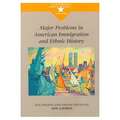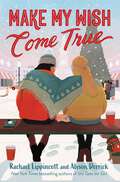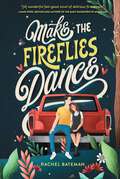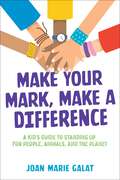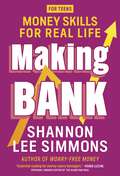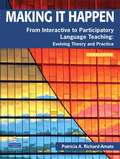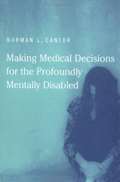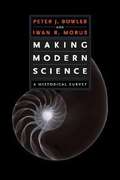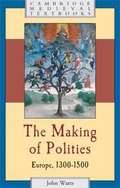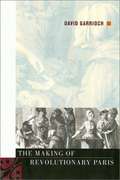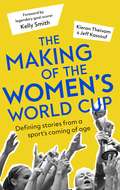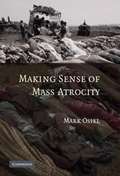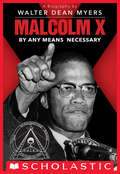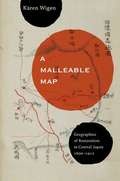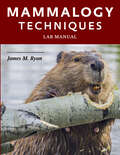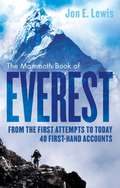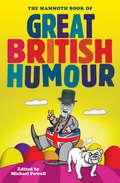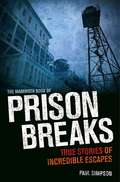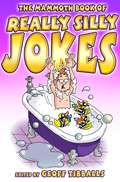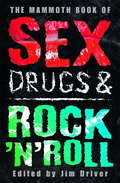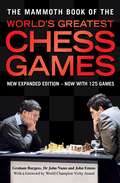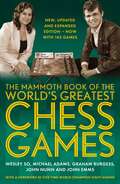- Table View
- List View
Major Problems in American Immigration and Ethnic History
by Jon GjerdeThis unique volume explores such themes as the political and economic forces that cause immigration; the alienation and uprootedness that often follow relocation; and the difficult questions of citizenship and assimilation.
Make My Wish Come True
by Rachael Lippincott Alyson Derrick&“Forgiveness, friendship, and vulnerability all shine as brightly as holiday lights in this snow-sprinkled romance.&” —Booklist (starred review) &‘Tis the season for holiday hijinks in this &“swoon-worthy&” (Kirkus Reviews) sapphic rom-com about a rising star and a small town girl going on twelve fake holidates from the New York Times bestselling authors of She Gets the Girl, Rachael Lippincott and Alyson Derrick!Twelve days of fake dates. Two holidays. One chance to convince everyone they&’re in love. Arden James is Hollywood&’s hottest teen actor. Infamously reckless, she&’s a constant in the tabloids. But when her messy reputation costs her an audition for her dream role, Arden and her publicist make up a lie to flip the script. Only, for the lie to work, she&’ll have to head home for the holidays for the first time in four years. Caroline Beckett has spent those last four years shining up a stellar portfolio that will get her into a top journalism program and convincing herself she could not be less interested in what her former best friend and first crush has been up to since she left without a word. But when Arden suddenly shows up at her doorstep with the promise of a real byline in Cosmopolitan in exchange for a write up on their &“secret romance&” and twelve snow-covered holidates in their Christmas-obsessed hometown, Caroline can&’t help but be tempted into playing along. It should be easy enough to stand each other for twelve days to make their dreams come true, right? But when old feelings start to bubble up, so do new holiday wishes that might just have Arden and Caroline falling faster than that Christmas Eve snow…
Make the Fireflies Dance
by Rachel BatemanIn this rom com from the author of Someone Else's Summer, a hopeless romantic juggles senior year stress, family problems, and faulty friendships around the end of senior year and prom. Quincy Walker is a hopeless romantic, so when she's kissed by a stranger in a dark theater, her rom-com obsessed imagination begins plotting the perfect movie-version ending to her senior year (which ends, like all great high school rom-coms, with the prom). With the help of her friends, Operation Mystery Kisser is born: a plan to set Quin up on dates with all the guys who were at the theater that night so she can discover who kissed her. The only problem? Her friends insist on blind dates, and Quin hates letting go of control--just ask the members of her group for her final project for film class. As prom draws nearer, Quin is no closer to finding who her mystery kisser was, and she's not sure she wants to continue looking. Maybe it's her dad's failing health and her brother's absence; maybe it's the fact that she's fighting with her best friend; or maybe--just maybe--it's that she's falling for a guy who definitely isn't the one she's been looking for.
Make Your Mark, Make a Difference: A Kid's Guide to Standing Up for People, Animals, and the Planet
by Joan Marie GalatTake the first steps into activism with this comprehensive middle grade guide that empowers readers to choose and become knowledgeable in a cause they are most passionate to reform, and to create meaningful change through learning what&’s already been accomplished—and what can still be done.Getting involved can be an overwhelming prospect, but this guide provides readers with tools to become informed and effective activists with an accessible approach offering hope and perspective. From Black Lives Matter and light pollution to climate change and healthcare equity for all, the book leads readers through an overview of issues, an essential human rights background, and stories of how other young activists tackle local, national, and international problems. Readers will discover a multitude of ways to build change and learn that every contribution matters.
Making Bank: Money Skills for Real Life
by Shannon Lee SimmonsThe definitive young readers’ guide to tracking, saving, spending, enjoying and growing money“No one knows what money will be like when you grow up. But here’s the thing: life costs money. That has always been true and will still be true when you’re grown up. Whether you’re using babysitting money to buy takeout coffee with your pals today or trading digital tokens to buy an electric hovercar in twenty years, the same skills you must use to afford your Starbucks this week will be used tomorrow and every day after.Learn and practise just five skills around money today and you’ll be ready to take on the world, no matter how much things change in five years or fifty years. You got this.”Told through a series of conversations, helpful guides, easy tables and definitions, Making Bank invites young readers to discuss a subject that is easy to avoid: money. With her signature charm, Shannon Lee Simmons transforms the thornier aspects of finance into easy-to-understand concepts. Whether it’s figuring out how to save for a senior-year trip, wondering what the heck inflation is or trying to wrap your mind around credit, interest and crypto, Shannon approaches every subject with expertise and empathy. By focusing on how to track, save, spend, enjoy and grow their money, Making Bank rebuilds young readers’ relationship with it—one skill at a time.
Making It Count: The Improvement of Social Research and Theory
by Stanley LiebersonThere were many failures before humans successfully learned to fly. After watching birds flap their wings, bold and adventurous individuals built huge winglike structures, leaped off cliffs, flapped their wings vigorously, and broke their necks. There are principles of flight to be learned from watching the birds all right, but the wrong analogy had been drawn. In similar fashion, our empirical approach to social behavior is based on an analogy.
Making It Happen, from Interactive to Participatory: Language Teaching, Evolving Theory and Practice (4th Edition)
by Patricia A. Richard-AmatoNew to this edition: Separate chapters on implicit/explicit teaching and on a sociocultural/cognitive synthesis. New sections on focus form strategies, World Englishes, research directions, corpus analysis, dialogical assessment, and the Acoma heritage language program. The research has been updated throughout and reflects influential thinking for the 21st century. Part 1: Theoretical Considerations - Explores current theory and research; builds a case for emergent participatory teaching; and highlights literacy development, self-directed learning strategies, and current assessment issues and practices. Part II: Exploring Methods and Activities - Presents a practical reservoir from which teacher can draw as they develop their own methodologies and local practice. Part III: Putting It All Together: Some Practical Issues - Considers issues critical to program development, lesson design, textbook and computer program selection, video use; teacher research and professional development (including SOP). Part IV: Programs in Action - Describes K-Adult Programs (ESL, Foreign Language, Bilingual, and Tribal Heritage). Part V: Case Studies: Teacher Narrations to Stimulate Professional Dialogue - Presents case studies, ranging from kindergarten through university levels.
Making Medical Decisions for the Profoundly Mentally Disabled
by Norman L. CantorNorman Cantor analyzes the legal and moral status of people with profound mental disabilities -- those with extreme cognitive impairments that prevent their exercise of medical self-determination. He proposes a legal and moral framework for surrogate medical decision making on their behalf. The issues Cantor explores will be of interest to professionals in law, medicine, psychology, philosophy, and ethics, as well as to parents, guardians, and health care providers who face perplexing issues in the context of surrogate medical decision making. The profoundly mentally disabled are thought by some moral philosophers to lack the minimum cognitive ability for personhood. Countering this position, Cantor advances both theoretical and practical arguments for according them full legal and moral status. He also argues that the concept of intrinsic human dignity should have an integral role in shaping the bounds of surrogate decision making. Thus, he claims, while profoundly mentally disabled persons are not entitled to make their own medical decisions, respect for intrinsic human dignity dictates their right to have a conscientious surrogate make medical decisions on their behalf. Cantor discusses the criteria that bind such surrogates. He asserts, contrary to popular wisdom, that the best interests of the disabled person are not always the determinative standard: the interests of family or others can sometimes be considered. Surrogates may even, consistent with the intrinsic human dignity standard, sometimes authorize tissue donation or participation in non-therapeutic medical research by profoundly disabled persons. Intrinsic human dignity limits the occasions for such decisions and dictates close attention to the preferences and feelings of the profoundly disabled persons themselves. Cantor also analyzes the underlying philosophical rationale that makes these decision-making criteria consistent with law and morals.
Making Modern Science: A Historical Survey
by Peter J. Bowler Iwan R. MorusA textbook about the history of modern science with cross-references. The book is divided into two parts, one on episodes, the other on themes. It covers all major developments in scientific thinking--evolutionism, genetics, nuclear physics, and modern cosmology.
The Making of Polities: Europe, 1300-1500
by John WattsThis major survey of political life in late medieval Europe - the first for more than thirty years - provides an entirely new framework for understanding the developments that shaped this turbulent period. Rather than emphasising crisis, decline, disorder or the birth of the modern state, this account centres on the mixed results of political and governmental growth across the continent. The age of the Hundred Years War, schism and revolt was also a time of rapid growth in jurisdiction, taxation and representation, of spreading literacy and evolving political technique. This mixture of state formation and political convulsion lay at the heart of the 'making of polities'. Offering a full introduction to political events and processes from the fourteenth century to the sixteenth, this book combines a broad, comparative account with discussion of individual regions and states, including eastern and northern Europe alongside the more familiar west and south.
The Making of Revolutionary Paris
by David GarriochA sweeping, beautifully written, illustrated history of the world's most fascinating city--Paris--during the eighteenth century.
The Making of the Women's World Cup: Defining stories from a sports coming of age
by Kieran Theivam Jeff KassoufWith a foreword by England legend Kelly Smith, the country's all-time record goalscorer and a player widely considered one of the best to have played the game.The exciting story of one of the fastest growing sports in the world, played by over 30 million girls and women. Over 25 million people tuned in for the Americans' 2015 Women's World Cup final victory - the most-watched football match in United States history. The Making of the Women's World Cup details the most incredible tales from previous Women's World Cups, including: Carli Lloyd's 13-minute hat trick and the worldwide movement set off by 2015How Japan made their country smile for the first time since the devastating tsunamiThe USA's World Cup triumph on home soil in 1999Germany's back-to-back titles in 2003 and 2007 Marta's magic: The birth of a Brazilian iconHow Kelly Smith announced her arrival with the kiss of a bootThe beginnings of Australia's golden generation The 122nd-minute USA equalizer against Brazil: the quarterfinal that changed everythingThe dawn of the Lionesses: England joins world elite through tears of joy and despair
Making Sense of Mass Atrocity
by Mark Osiel"Who done it?" is not the first question that comes to mind when one seeks to make sense of mass atrocity. So brazen are the leader-culprits in their apologetics for the harms, so wrenching the human destruction clearly wrought, meticulously documented by many credible sources. Yet in legal terms, mass atrocity remains disconcertingly elusive. The perversity of its perpetrators is polymorphic, impeding criminal courts from tracing true lines of responsibility in ways intelligible through law's pre-existing categories, designed with simpler stuff in mind. Genocide, crimes against humanity, and the worst war crimes are possible only when the state or other organizations mobilize and coordinate the efforts of many people. Responsibility for mass atrocity is therefore always widely shared, often by thousands. Yet criminal law, with its liberal underpinnings, insists on blaming particular individuals for isolated acts. Is such law therefore constitutionally unable to make any sense of the most catastrophic conflagrations of our time? Drawing on the experience of several recent prosecutions (both national and international), this book trenchantly diagnoses law's limits at such times and offers a spirited defense of its moral and intellectual resources for meeting the vexing challenge of holding anyone criminally accountable for mass atrocity. Just as today's war criminals develop new methods of eluding law's historic grasp, so criminal law flexibly devises novel responses to their stratagems. Mark Osiel examines several such recent legal innovations in international jurisprudence and proposes still others.
Making Supervision Work for You: A Student's Guide (SAGE Study Skills Series)
by Jerry Wellington'Amongst the plethora of advice and guidance books and articles now available for postgraduate researchers, I would advise my students to select this one as providing insight not simply on what to do but also on why and how in relation to developing an effective working relationship with their supervisors. Since it addresses most of the new demands emerging in the doctoral world as well as those standard ones that have impacted previously, I would also recommend it to new or less experienced supervisors' - Professor Pam Denicolo, University of Reading Making Supervision Work For You discusses the entire supervision process from the student's perspective, as well as considering the supervisor's viewpoint and constraints. The author covers all phases of the student's 'journey', from induction through to final completion and examination of the thesis and the viva voce. The book illustrates many of the key issues in supervision by drawing upon extensive material from recent interviews with a range of supervisors and students. This book presents new ideas, regulations and codes of practice, and offers practical suggestions for students. It emphasizes students' experiences and needs, whilst also maintaining a focus on the supervisor's perspective and the demands of assessment at post-graduate level. The book is primarily aimed at Post-graduate students but will also be useful for undergraduates in their final year and equally for new or experienced supervisors. Jerry Wellington is a widely published author. He is professor in the School of Education at the University of Sheffield, with extensive experience of supervision, internal and external examining. SAGE Study Skills are essential study guides for students of all levels. From how to write great essays and succeeding at university, to writing your undergraduate dissertation and doing postgraduate research, SAGE Study Skills help you get the best from your time at university.
Malcolm X (Scholastic Focus): By Any Means Necessary
by Walter Dean MyersA classic and highly acclaimed biography of civil rights activist Malcolm X, ever more relevant for today's readers.As a 14-year-old he was Malcolm Little, the president of his class and a top student. At 16 he was hustling tips at a Boston nightclub. In Harlem he was known as Detroit Red, a slick street operator. At 19 he was back in Boston, leading a gang of burglars. At 20 he was in prison.It was in prison that Malcolm Little started the journey that would lead him to adopt the name Malcolm X, and there he developed his beliefs about what being black means in America: beliefs that shook America then, and still shake America today.Few men in American history are as controversial or compelling as Malcolm X. In this Coretta Scott King Honor Book, Walter Dean Myers, winner of a Newbery Honor and four-time Coretta Scott King Award winner, portrays Malcolm X as prophet, dealer, convict, troublemaker, revolutionary, and voice of black militancy.
A Malleable Map: Geographies of Restoration in Central Japan, 1600-1912
by Karen WigenDrawing on a wide range of geographical documents from Shinano, Wigen argues that both the founder of the Tokugawa Shogunate (1600-1868) and the reformers of the Meiji era (1868-1912) recruited the classical map to serve the cause of administrative reform.
Mammalogy Techniques Lab Manual
by James M. RyanGet outside! A hands-on lab manual for instructors incorporating fieldwork into their courses on mammalogy.Mammals inhabit nearly every continent and every sea. They have adapted to life underground, in the frozen Arctic, the hottest deserts, and every habitat in-between. In Mammalogy Techniques Lab Manual—the only field manual devoted to training the next generation of mammalogists—biologist and educator James M. Ryan details the modern research techniques today’s professionals use to study mammals wherever they are found.Ideal for any mammalogy or wildlife biology course, this clear and practical guide aids students by getting them outside to study mammals in their natural environments. Twenty comprehensive chapters cover skull and tooth identification, radio and satellite GPS tracking, phylogeny construction, mark and recapture techniques, camera trapping, museum specimen preparation, optimal foraging, and DNA extraction, among other topics. Each chapter includes several exercises with step-by-step instructions for students to collect and analyze their own data, along with background information, downloadable sample data sets (to use when it is not practical to be out in the field), and detailed descriptions of useful open-source software tools.This pragmatic resource provides students with real-world experience practicing the complex techniques used by modern wildlife biologists. With more than 60 applied exercises to choose from in this unique manual, students will quickly acquire the scientific skills essential for a career working with mammals.
The Mammoth Book Of Everest: From the first attempts to today, 40 first-hand accounts
by Jon E. LewisThis selection of the very best writing on Everest begins with the first attempts and continues, via Mallory's failed bid and Hillary and Tenzing's triumph, to the disasters of recent years. It features 35 white-knuckle accounts of climbing on the world's highest mountain, with all the tragedy and triumph of humankind's striving for the top of the world, by those who know the 'Death Zone' best - the climbers themselves. But this is much more than just the best of exhilarating first-hand accounts of climbing on Everest. It includes the full history of the conquest of Everest, and provides an evocative portrait of the cruel, natural beauty of Chomolungma, 'The Mother Goddess of the World'.
The Mammoth Book of Great British Humour (The Mammoth Bks.)
by Michael PowellA doorstopper of a collection of the very best of both contemporary and classic British wit and humour. From Monty Python's 'Nudge, nudge, wink, wink, say no more . . .' to Dan Antopolski's 'Hedgehogs. Why can't they just share the hedge?'. From George Bernard Shaw to Michael McIntyre, from Eric Morecombe to Omid Djalili, and from Oscar Wilde to Jimmy Carr, a side-splitting look at Britain, the British and life in general. Including these gems from Britain's finest comedians:I was delighted to learn that my friend's schadenfreude was not as satisfying as mine. Armando Iannucci.I went on a girls' night out recently. The invitation said 'dress to kill'. I went as Rose West. Zoe LyonsFor a while I was the perfect mother. Then the Pethidine wore off. Jenny Eclair.My girlfriend was complaining last night that I never listen to her. Or something like that. Jack Dee.Why do dogs always race to the door when the doorbell rings because it's hardly ever for them? Harry Hill.Arse-gravy of the very worst kind. Stephen Fry on The Da Vinci Code.You have to come up with this shit every year. Last week I just wrote "I still love you, see last year's card for full details." Michael McIntyre on Valentines Day.I went to the doctor and he said, 'You've got hypochondria.' I said, 'Not that as well!'Tim Vine.I have the body of an eighteen year old. I keep it in the fridge. Spike Milligan.When someone close to you dies, move seats. Peter Kay.My neighbour asked if he could use my lawnmower and I told him of course he could, so long as he didn't take it out of my garden. Eric Morecambe.My dad's dying wish was to have his family around him. I can't help thinking he would have been better off with more oxygen. Jimmy Carr.Eighty-two point six per cent of statistics are made up on the spot. Vic Reeves.A bird in the hand invariably shits on your wrist. Billy Connolly.Getting divorced isn't like a bereavement at all, because if he's died, I'd have had me mortgage paid, and I could've danced on his grave. Sarah Millican.My greatest hero is Nelson Mandela: incarcerated for 25 years, he was released in 1990, he's been out about 18 years now and he hasn't re-offended. Ricky Gervais.If you want to confuse a girl, buy her a pair of chocolate shoes. Milton Jones.Phil Collins is losing his hearing, making him the luckiest man at a Phil Collins Concert. Simon Amstell.We'll continue our investigation into the political beliefs of nudists. We've already noticed a definite swing to the left. Ronnie Barker.A guy walks into the psychiatrist wearing only Clingfilm for shorts. The psychiatrist says, "Well, I can clearly see your nuts. Tommy Cooper
The Mammoth Book of Prison Breaks
by Paul SimpsonTrue stories of prison breaks including those of Frank Abagnale, whose story is told in Catch Me If You Can; Henri Charrière who claimed to have escaped from the supposedly inescapable Devil's Island - the true story as opposed to his questionable memoir, Papillon; Bud Day, said to be the only US serviceman ever to have escaped to South Vietnam; the six prisoners who escaped from Death Row in Mecklenburg Correctional Center; and Pascal Payeret, the French armed robber who escaped not once, but twice from French prisons with the help of a helicopter.
The Mammoth Book of Really Silly Jokes: Humour for the whole family (The Mammoth Bks.)
by Geoff TibballsThe biggest and best collection of jokes for all the family to enjoy. 8,000 rib-ticklers, covering every subject under the sun from Aardvarks to Zombies, including chicken jokes, doctor-doctor jokes, elephant jokes, horror jokes, knock-knock jokes, excruciating puns, riddles, school jokes, sports jokes and waiter jokes. Most of the jokes are sharp one-liners but there is also a scattering of slightly longer stories.
The Mammoth Book of Sex, Drugs & Rock 'n' Roll
by Jim DriverOver 60 gripping accounts tracking the dark side of rock 'n' roll from the early days of the drugs-and-drink culture, and the birth of rock 'n' roll, through The Beatles, Stones, Sex Pistols, Madonna, Kurt Cobain and Oasis, to Amy Winehouse, Pete Doherty and other stars of the current rock-music scene.From trashed hotel rooms to cars in swimming pools, all rock 'n' roll's excesses are here, including murder and sexual deviancy, surprising brushes with the law that the stars thought they'd kept quiet, early and tragic deaths, drug overdoses, robbery, mis-marriages and groupies by the truckload
The Mammoth Book of the World's Greatest Chess Games: New edn
by Graham Burgess John Nunn John EmmsThe 125 greatest chess games of all time, selected, analysed, re-evaluated and explained by a team of British experts and illustrated with over 1,000 chess diagrams. Join the authors in studying these games, the cream of two centuries of international chess, and develop your own chess-playing skills - whatever your current standard. Instructive points at the end of each game highlight the lessons to be learned.First published in 1998, a second edition of The Mammoth Book of the World's Greatest Chess Games in 2004 included an additional 12 games. This edition includes a further 13 games as well as some significant revisions to the analysis and information regarding other games in earlier editions of the book, facilitated by the use of a variety of chess software.
The Mammoth Book of the World's Greatest Chess Games: New edn
by Wesley So Michael Adams Graham Burgess John Nunn John EmmsImprove your chess by studying the greatest games of all time, from Adolf Anderssen's 'Immortal Game' to Magnus Carlsen's world championship victories, and featuring a foreword by five-times World Champion Vishy Anand.This book is written by an all-star team of authors. Wesley So is the reigning Fischer Random World Champion, the 2017 US Champion and the winner of the 2016 Grand Chess Tour. Michael Adams has been the top British player for the last quarter of a century and was a finalist in the 2004 FIDE World Championship. Graham Burgess is the author of thirty books, a former champion of the Danish region of Funen, and holds the world record for marathon blitz chess playing. John Nunn is a three-time winner of both the World Solving Championship and the British Chess Federation Book of the Year Award. John Emms is an experienced chess coach and writer, who finished equal first in the 1997 British Championship and was chess columnist of the Young Telegraph.The 145 greatest chess games of all time, selected, analysed, re-evaluated and explained by a team of British and American experts and illustrated with over 1,100 chess diagrams. Join the authors in studying these games, the cream of two centuries of international chess, and develop your own chess-playing skills - whatever your current standard. Instructive points at the end of each game highlight the lessons to be learned.First published in 1998, a second edition of The Mammoth Book of the World's Greatest Chess Games in 2004 included an additional twelve games. Another new edition in 2010 included a further thirteen games as well as some significant revisions to the analysis and information regarding other games in earlier editions of the book, facilitated by the use of a variety of chess software. This 2021 edition, further updated and expanded, now includes 145 games.The authors have made full use of the new generation of chess analysis engines that apply neural-network based AI.
The Mammoth Book of Travel in Dangerous Places: Arabia
by John KeayEscape from Riyadh - William Gifford PalgraveA scholar and a solider, a Jesuit and a Jew, a French spy and a British ambassador- Palgrave was a man of contradictions, all of them highly compromised when in 1862-3, fortified by Pius IX's blessing and Napoleon III's cash, he attempted the first west- east crossing of the Arabian peninsular. To steely nerves and a genius for disguise he owed his eventual success; but not before both were sorely tested when, as a Syrian doctor, he became the first European to enter Riyadh. The desert capital of the fanatical Wahabis, dangerous for an infidel at the best of times, was then doubly so as the sons of the ageing King Feisal intrigued for power.Desert Days - Charles Montagu DoughtyDuring two years (1875-7) wandering in Central Arabia Doughty broke little new ground; dependant on desert charity, his achievement was simply to have survived. Yet his book, Arabia Deserta, was instantly recognized as a classic. Its eccentric prose proves well suited to that minute observation and experience of Bedouin life which was Doughty's main contribution to exploration. T.E. Lawrence called it "a bible of a kind"; both syntax and subject matter have biblical resonances, as in this description of a day's march, or rahla.
